In this article
Are you new to Banana Accounting Plus? Not a problem. On this page we briefly show you what you will find on the main screen and ho the various elements work.
At first glance, Banana Accounting is similar to Excel, based on tables, and its mode of use is very practical and intuitive. But you will soon discover that Banana Accounting Plus does so much more.
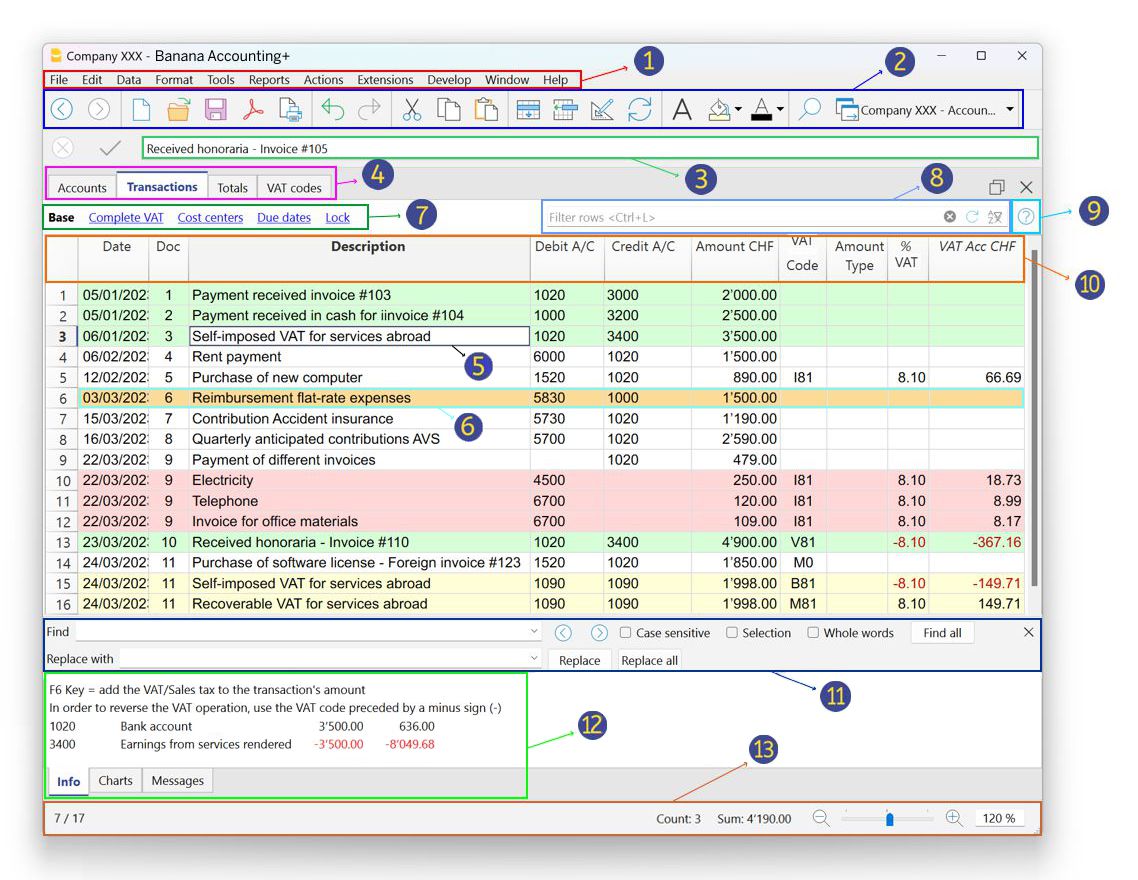
1. The menu bar
The menu bar changes depending on which application is open. Each menu has specific commands. The menus in accounting applications are: File, Edit, Data, Format, Tools, Reports, Actions, Extensions, Windows, Help.
From the Help menu you can manage the data of the Banana Accounting Plus subscription.
Warning: In Mac operating systems, the menu bar is located at the top, to the right of the Apple logo in the shape of an apple.
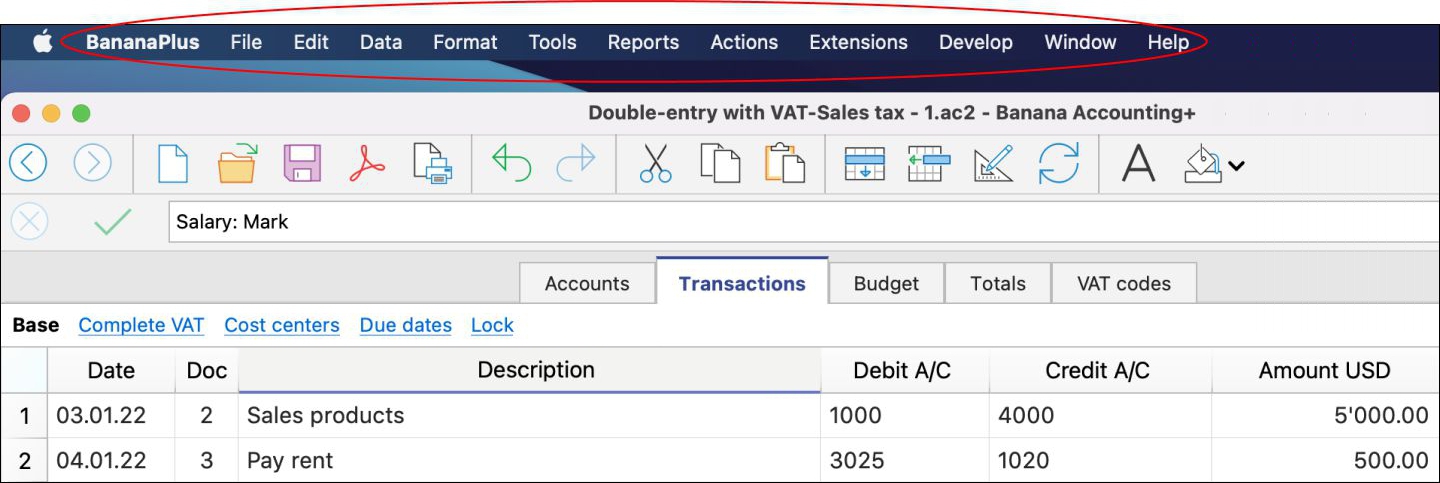
New: In the Window Menu you have several commands, which allow you to, among other things
- Change the layout of the data windows (side-by-side or cascading)
- Choose different settings from the Appearance command:
- Choose which interface elements to display, to adapt them to small screens.
- Choose the display theme.
- Make the Develop menu visible.
2. The toolbar
The toolbar provides quick access to the most frequently used dialogues and commands.
Simply move the mouse over the desired icon and wait a moment for a description of what it means.
New: If you have several files open, you can now easily see which one you are working on and switch between them very simply from the toolbar.

3. Text input area
Normally, texts are written directly in the cell, but they also appear in the area below the toolbar, where they can also be edited. Several functions speed up and automate their entry.
4. The tables
Each file consists of several tables, which show different accounting or application contents. Switch from one table to another by simply touching the table name with the mouse. Tables vary depending on which application is open. Working with tables allows you to always have data sorted and grouped according to content.
There are main tables (fixed) and auxiliary tables (which appear following certain commands). Auxiliary tables (i.e. generated by the user) must be updated if there is a change or addition of data, simply by clicking on the icon at the top right of the table ![]()
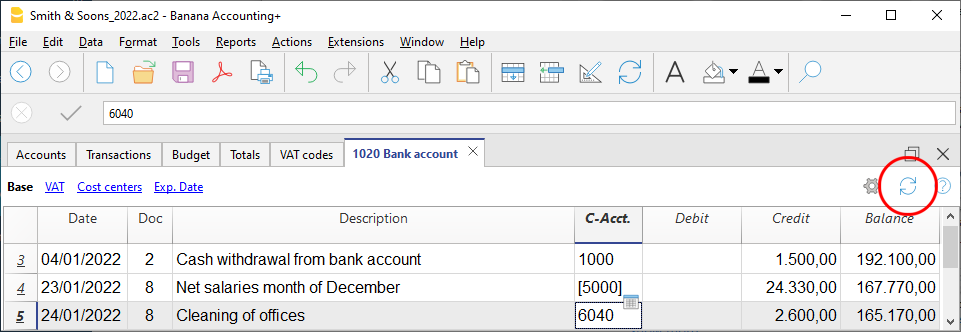
In addition to the various reports available, Banana Accounting Plus allows you to print everything you see on the screen in any table (see Page setup - last paragraph). For more information, visit the Printouts/Preview page.
5. The cells
The cell in Banana Accounting is the basic unit of the table: the intersection between a row and a column.
Each cell can contain text, numbers, dates, account codes or calculated values. In Banana, cells inherit the type and rules from their respective column.
You can select it, edit it, copy/paste it, and also insert commented values within square brackets [ ].
Values or text entered within square brackets [ ] are not considered by the program. They are interpreted as annotations and have no effect on the calculation of balances or transactions, except in specific cases specified in the documentation.
6. The rows
In Banana Accounting, a row represents a single transaction or a data element in a table.
Each row is made up of multiple cells, distributed across columns (date, document, description, accounts, amounts, etc.).
In the Transactions table, for example, a row corresponds to a complete accounting entry: it contains the date, the document number, the description, the debit/credit accounts, and the amount.
In other tables (Accounts, Customers/Suppliers, Invoices), the row serves to define an account, a customer, or an invoice detail.
7. The views
Views are different ways of displaying data from the same table, showing only certain columns. They are very useful when you want to display data differently, without altering the basic settings. Switch from one view to another simply by touching the name of the view with the mouse.
The views are located in the area below the tables and can be customised with the Tables setup command. There is also the possibility of creating new ones.
8. The Filter
The Filter rows function, available in the Advanced plan of Banana Accounting Plus, allows to instantly search, find and modify previously entered transactions. Together with the Temporary Sort Rows represents an important innovation for speeding up accounting control.
For further information visit the page Filter and Temporary Sort rows.
9. Contextual help
In Banana Accounting Plus, contextual help gives you immediate help related to exactly what you are working on. This is done in several complementary ways:
- A - The error message window, which the programme displays when it detects a possible error:
- If you press OK you are shown each individual message.
- If you press Help you are taken to the page explaining the error message with possible solutions.
- If you press Do Not Report, all error messages are saved in the Error Message window.
- B - Question mark symbol at the top right of the table question mark table

A click on the symbol takes you to our Documentation page, where you can find in-depth information on the use of the table and all other programme functions.
- C - Question mark symbol at the bottom
 of the Info or Message window
of the Info or Message window
Clicking on this symbol takes you to the page explaining the error message and possible solutions. - D - Help button in dialogue windows
Clicking this button displays the online explanation page of the opened dialogue box or error message.
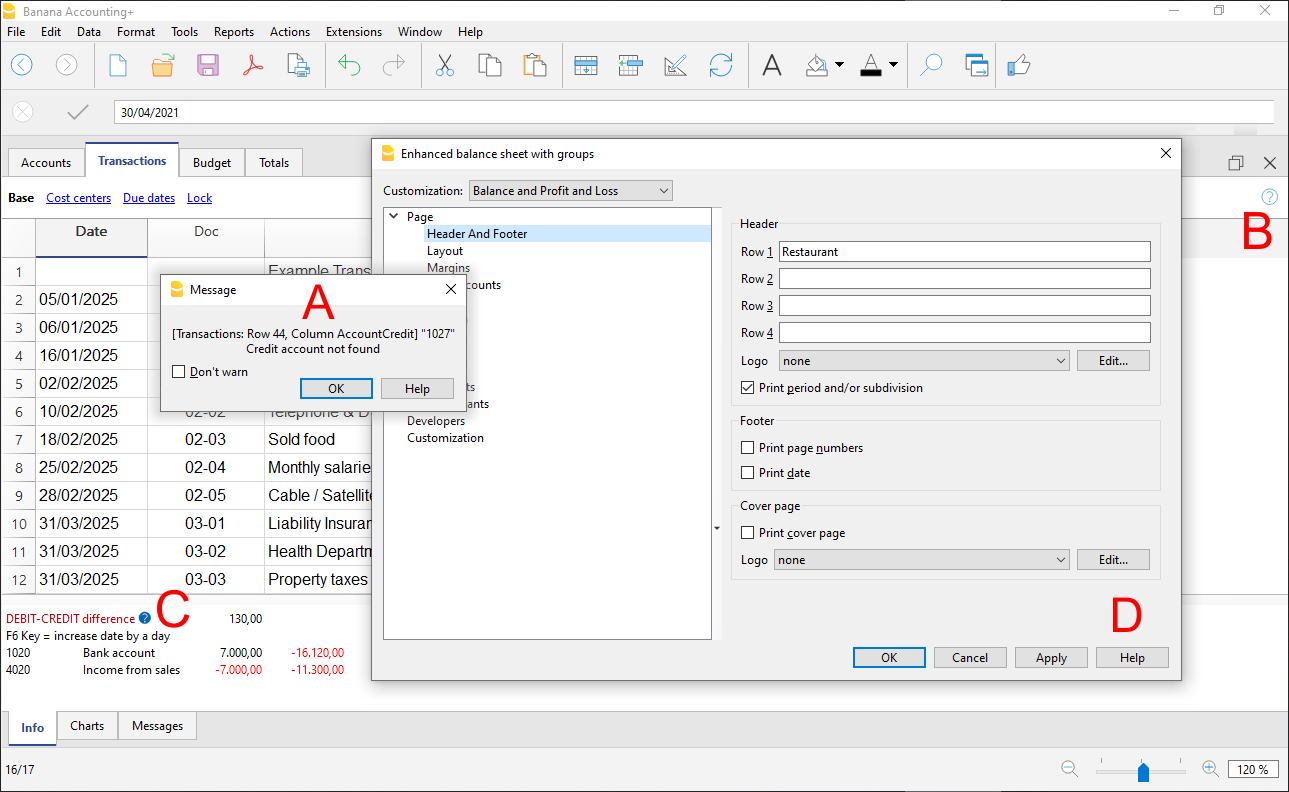
10. The columns
Columns are the vertical elements of the table. Each column has its own header. The arrangement, size, description, format, width, style and alignment of the columns can be customised using the functions found in the menu Data → Columns setup
In some columns the data is entered by the user, while in others the programme automatically enters the data and is therefore not editable by the user (e.g. account card columns).
You can also add new columns via Data → Columns setup, but if they contain values they will not be processed by the programme.
11. Find and replace
The Find and Replace function is activated from the Data menu and remains visible until manually closed. It is very practical for finding and changing texts quickly and easily in the table. Not to be confused with the Rename command (only in the Advanced plan), which instead changes the name of an account, VAT code or other throughout the file.
12. The Info windows
This is the area located at the bottom of the screen, where useful information about the table and the box you are in is displayed. This area is divided into three very useful windows that provide immediate information:
- the Info window reports the contents of the row and cell in which you are (e.g. name and balance of the account, VAT code and description of the code used).
- the Messages window, reports error messages.
- the Charts window, displays the chart of the contents of the cell or row you are in (e.g. if you are in an account, the chart with the account's trend appears).
Switch between windows by simply touching the window name with the mouse.
The Info window
The Info window shows the information concerning the cell and the line in which you are: the names and codes of the accounts involved in the entry, the amounts and the remaining balances. When there is an error, the difference is displayed here in red.
- Clicking on the question mark symbol
 takes you to the page where the error is explained.
takes you to the page where the error is explained.
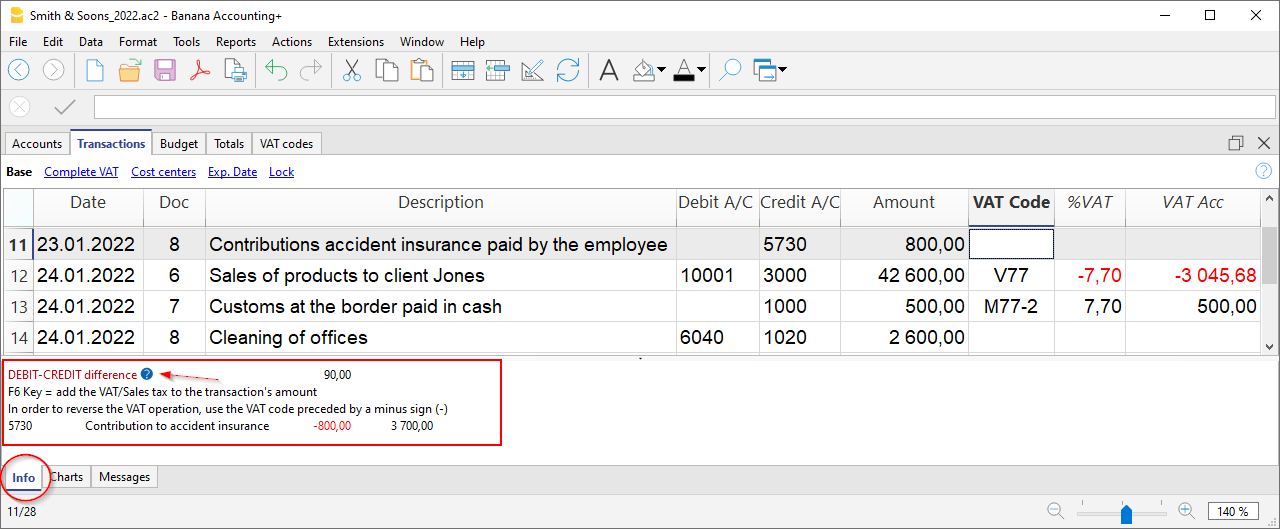
The Messages window
When the programme encounters errors, a dialogue box appears to report them:
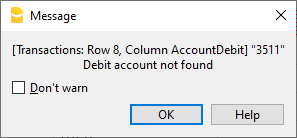
- Press OK to view each individual message.
- If you press Do Not Report, all error messages are saved in the Error Messages window.
- Pressing Help takes you to the page explaining the error with possible solutions (Contextual Help).
The Messages window contains a list of errors that have been reported by the programme.
- From the Messages window, double-click on the error message to jump to the line that generated the error.
- A click on the question mark symbol
 takes you to the page explaining the message.
takes you to the page explaining the message.
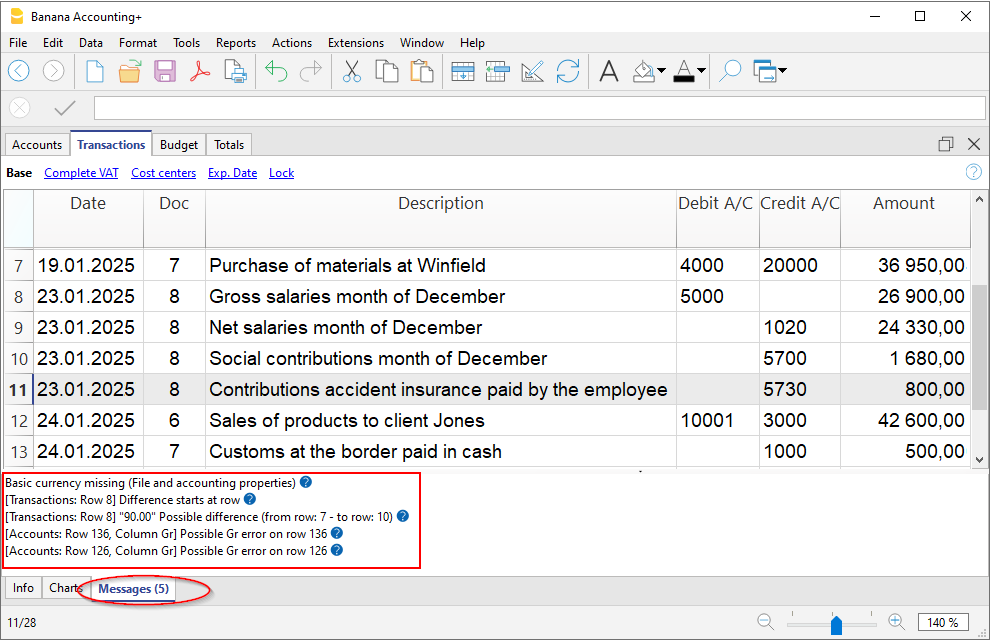
The Charts window
By selecting an account or a group, you obtain the chart in the Charts window at the bottom. The chart immediately provides you with the trend of the situation, including a comparison between forecast and actual situation. You have an immediate view over time without having to consult the amounts.
With the Advanced plan of Banana Accounting Plus, it is now also possible to copy, export and print graphs, as well as copy the data that determined the graph to the clipboard. More information on the Charts page.
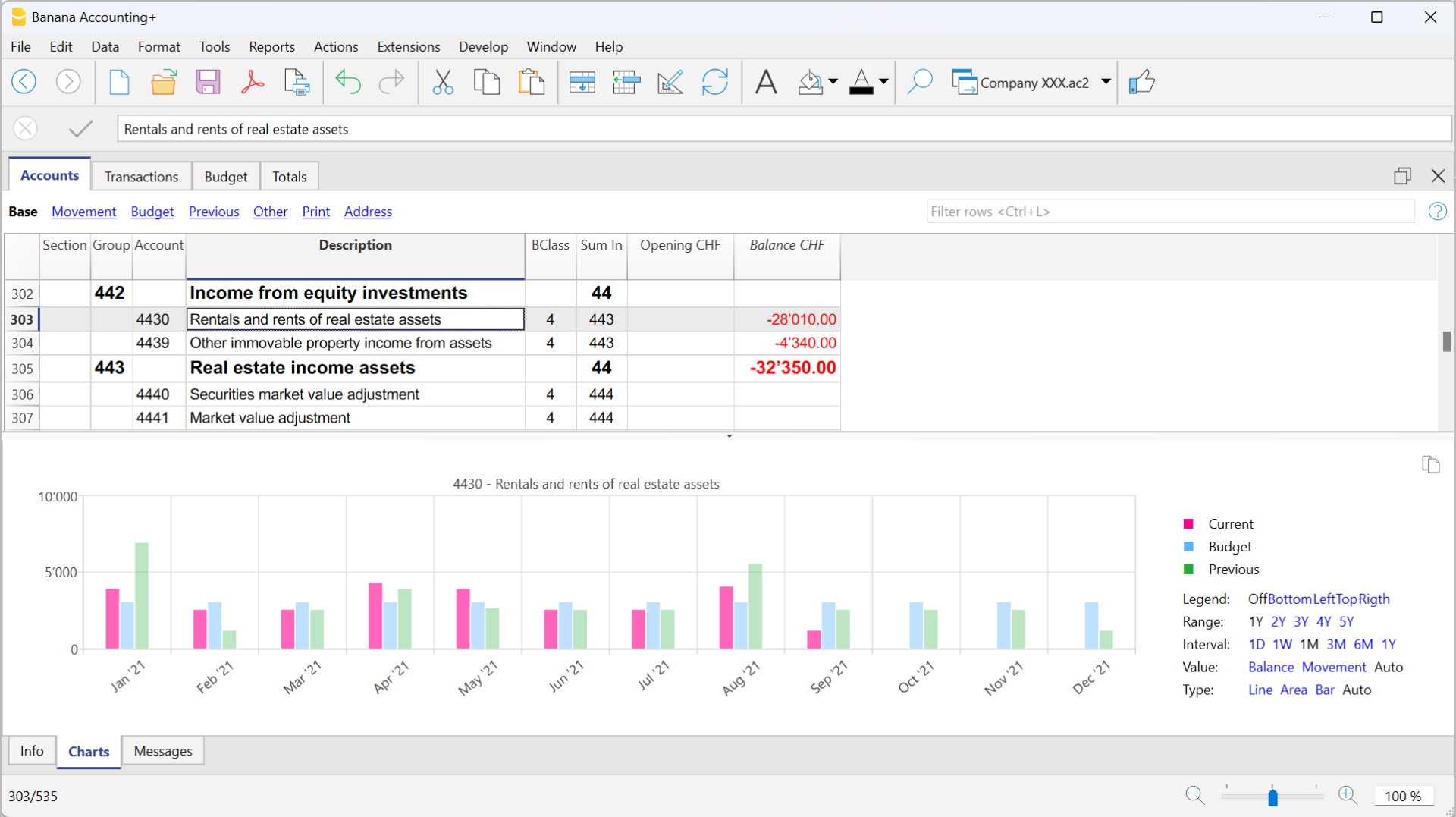
13. The status bar
It is located at the bottom of the programme window and contains the following information:
- Line number of the selected cell/number of rows in the table.
- If the Filter is active, the number of visible rows is also indicated
- If several numeric or time-counter type cells are selected, this is obtained:
- Count: Number of selected cells containing numbers.
- Sum : Sum of the values of the selected cells.
In the image above, 3 numeric cells were selected (1'500 + 1'500 + 1'910) and in fact the total is 4'910 in the status bar.
- Zoom
- To enlarge or reduce the size of tables.
- To change the text size of menus, use the operating system settings.
- See also Programme Options.

If the status bar is not displayed, you can enable it from the Window > Appearance menu.
What's New
In the latest release of Banana Accounting Plus, you can copy the sum of amounts to the clipboard.
